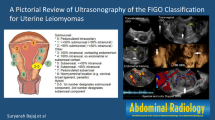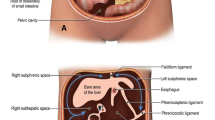Abstract
Minimally invasive gastrointestinal, genitourinary, and gynecological procedures are widely used in the clinical practice for diagnostic and therapeutic purposes. Complications both minor and major are not uncommon with these procedures. Imaging plays an important role in the detection and optimal management of these complications. Familiarity with the clinical and imaging features of these complications by radiologists can help in their timely detection.











Similar content being viewed by others
References
Loperfido S, Angelini G, Benedetti G et al (1998) Major early complications from diagnostic and therapeutic ERCP: a prospective multicenter study. Gastrointest Endosc 48:1–10
Jones WB, Blackwell J, McKinley B, Trocha S (2014) What is the risk of diagnostic endoscopic retrograde cholangiopancreatography before cholecystectomy? Am Surg 80:746–751
Cohen SA, Siegel JH, Kasmin FE (1996) Complications of diagnostic and therapeutic ERCP. Abdom Imaging 21:385–394
Pannu HK, Fishman EK (2001) Complications of endoscopic retrograde cholangiopancreatography: spectrum of abnormalities demonstrated with CT. Radiographics 21:1441–1453
Cotton PB, Lehman G, Vennes J et al (1991) Endoscopic sphincterotomy complications and their management: an attempt at consensus. Gastrointest Endosc 37:383–393
Stapfer M, Selby RR, Stain SC et al (2000) Management of duodenal perforation after endoscopic retrograde cholangiopancreatography and sphincterotomy. Ann Surg 232:191–198
Kalfarentzos FE, Kehagias J, Kakkos SK et al (1999) Treatment of patients with severe acute necrotizing pancreatitis based on prospective evaluation. Hepatogastroenterology 46:3249–3256
Freeman ML, Nelson DB, Sherman S et al (1996) Complications of endoscopic biliary sphincterotomy. N Engl J Med 335:909–918
Hahn PF, Stark DD, Vici LG, Ferrucci JT Jr (1986) Duodenal hematoma: the ring sign in MR imaging. Radiology 159:379–382
Kullman E, Borch K, Lindstrom E, Ansehn S, Ihse I, Anderberg B (1992) Bacteremia following diagnostic and therapeutic ERCP. Gastrointest Endosc 38:444–449
Aliperti G (1996) Complications related to diagnostic and therapeutic endoscopic retrograde cholangiopancreatography. Gastrointest Endosc Clin N Am 6:379–407
Enns R, Eloubeidi MA, Mergener K et al (2002) ERCP-related perforations: risk factors and management. Endoscopy 34:293–298
Duca S, Bala O, Al-Hajjar N et al (2003) Laparoscopic cholecystectomy: incidents and complications. A retrospective analysis of 9542 consecutive laparoscopic operations. HPB 5:152–158
Sathesh-Kumar T, Saklani AP, Vinayagam R, Blackett RL (2004) Spilled gall stones during laparoscopic cholecystectomy: a review of the literature. Postgrad Med J 80:77–79
Bismuth H, Majno PE (2001) Biliary strictures: classification based on the principles of surgical treatment. World J Surg 25:1241–1244
McGahan JP, Stein M (1995) Complications of laparoscopic cholecystectomy: imaging and intervention. AJR Am J Roentgenol 165:1089–1097
Kulber DA, Berci G, Paz-Partlow M, Ashok G, Hiatt JR (1994) Value of early cholescintigraphy in detection of biliary complications after laparoscopic cholecystectomy. Am Surg 60:190–193
Kantarci M, Pirimoglu B, Karabulut N et al (2013) Non-invasive detection of biliary leaks using Gd-EOB-DTPA-enhanced MR cholangiography: comparison with T2-weighted MR cholangiography. Eur Radiol 23:2713–2722
Khalid M, Rashid M (2009) Gallstone abscess: a delayed complication of spilled gallstone after laparoscopic cholecystectomy. Emerg Radiol 16:227–229
Hashimoto M, Matsuda M, Watanabe G (2003) Reduction of the risk of unretrieved stones during laparoscopic cholecystectomy. Hepatogastroenterology 50:326–328
Memon MA, Deeik RK, Maffi TR, Fitzgibbons RJ Jr (1999) The outcome of unretrieved gallstones in the peritoneal cavity during laparoscopic cholecystectomy. A prospective analysis. Surg Endosc 13:848–857
Mayol J, Garcia-Aguilar J, Ortiz-Oshiro E, De-Diego Carmona JA, Fernandez-Represa JA (1997) Risks of the minimal access approach for laparoscopic surgery: multivariate analysis of morbidity related to umbilical trocar insertion. World J Surg 21:529–533
Ho AC, Horton KM, Fishman EK (2000) Perforation of the small bowel as a complication of laparoscopic cholecystectomy: CT findings. Clin Imaging 24:204–206
Schafer M, Lauper M, Krahenbuhl L (2001) Trocar and Veress needle injuries during laparoscopy. Surg Endosc 15:275–280
Roche-Nagle G, Maceneaney, Harte P (2006) Pseudo-aneurysm of the hepatic artery after laparoscopic cholecystectomy: a case report. J Minim Access Surg 2:73–75
Zhang JJ, Dong CX, Meng XK, Ge LH, Zhang ZD, Zhao DF (2011) Right hepatic arterial pseudoaneurysm with hemobilia following minilaparotomy cholecystectomy: a rare complication. Ann Saudi Med 31:641–643
Carrafiello G, Lagana D, Dizonno M, Cotta E, Ianniello A, Fugazzola C (2008) Emergency percutaneous treatment in iatrogenic hepatic arterial injuries. Emerg Radiol 15:249–254
Waye JD, Lewis BS, Yessayan S (1992) Colonoscopy: a prospective report of complications. J Clin Gastroenterol 15:347–351
Levin TR, Zhao W, Conell C et al (2006) Complications of colonoscopy in an integrated health care delivery system. Ann Intern Med 145:880–886
Kim DH, Pickhardt PJ, Taylor AJ, Menias CO (2008) Imaging evaluation of complications at optical colonoscopy. Curr Probl Diagn Radiol 37:165–177
Gedebou TM, Wong RA, Rappaport WD, Jaffe P, Kahsai D, Hunter GC (1996) Clinical presentation and management of iatrogenic colon perforations. Am J Surg 172:454–457
Gibbs DH, Opelka FG, Beck DE, Hicks TC, Timmcke AE, Gathright JB Jr (1996) Postpolypectomy colonic hemorrhage. Dis Colon Rectum 39:806–810
Andersson RE (2014) Short-term complications and long-term morbidity of laparoscopic and open appendicectomy in a national cohort. Br J Surg 101:1135–1142
Abe T, Nagaie T, Miyazaki M, Ochi M, Fukuya T, Kajiyama K (2013) Risk factors of converting to laparotomy in laparoscopic appendectomy for acute appendicitis. Clin Exp Gastroenterol 6:109–114
Tonolini M, Villa F, Ippolito S, Petulla M, Bianco R (2014) Pictorial review of normal postoperative cross-sectional imaging findings and infectious complications following laparoscopic appendectomy. Insights Imaging 28:28
Johnston J, Myers DT, Williams TR (2014) Stump appendicitis: surgical background, CT appearance, and imaging mimics. Emerg Radiol 2:2
Israel GM, Hecht E, Bosniak MA (2006) CT and MR imaging of complications of partial nephrectomy. Radiographics 26:1419–1429
Gill IS, Matin SF, Desai MM et al (2003) Comparative analysis of laparoscopic versus open partial nephrectomy for renal tumors in 200 patients. J Urol 170:64–68
John J, Allen S, Perry M, Patel HR, O’Brien T (2008) Page kidney phenomenon presenting as acute renal failure after partial nephrectomy: a case report and review of the literature. Urol Int 80:440–443
Moore CJ, Rozen SM, Fishman EK (2004) Two cases of pseudoaneurysm of the renal artery following laparoscopic partial nephrectomy for renal cell carcinoma: CT angiographic evaluation. Emerg Radiol 10:193–196
Lopez VM, Glauser J (2010) A case of renal artery thrombosis with renal infarction. J Emerg Trauma Shock 3:0974–2700
Bansal U, Sawant A, Dhabalia J (2010) Subcapsular renal hematoma after ureterorenoscopy: an unknown complication of a known procedure. Urol Ann 2:119–121
Ngo TC, Lee JJ, Gonzalgo ML (2010) Renal pseudoaneurysm: an overview. Nat Rev Urol 7:619–625
Titton RL, Gervais DA, Hahn PF, Harisinghani MG, Arellano RS, Mueller PR (2003) Urine leaks and urinomas: diagnosis and imaging-guided intervention. Radiographics 23:1133–1147
Meeks JJ, Zhao LC, Navai N, Perry KT Jr, Nadler RB, Smith ND (2008) Risk factors and management of urine leaks after partial nephrectomy. J Urol 180:2375–2378
Rassweiler J, Teber D, Kuntz R, Hofmann R (2006) Complications of transurethral resection of the prostate (TURP)—incidence, management, and prevention. Eur Urol 50:969–979
Djavan B, Madersbacher S, Klingler C, Marberger M (1997) Urodynamic assessment of patients with acute urinary retention: is treatment failure after prostatectomy predictable? J Urol 158:1829–1833
Olapade-Olaopa EO, Solomon LZ, Carter CJ, Ahiaku EK, Chiverton SG (1998) Haematuria and clot retention after transurethral resection of the prostate: a pilot study. Br J Urol 82:624–627
Park SK, Cho WJ, Choi YS (2013) Fluid extravasation caused by bladder perforation during bipolar transurethral resection using saline solution—a case report. Korean J Anesthesiol 65:163–166
Patel BN, Gayer G (2014) Imaging of iatrogenic complications of the urinary tract: kidneys, ureters, and bladder. Radiol Clin North Am 52(5):1101–1116. doi:10.1016/j.rcl.2014.05.013
Ishak C, Kanth N (2011) Bladder trauma: multidetector computed tomography cystography. Emerg Radiol 18:321–327
Lima E, Rolanda C, Osorio L et al (2009) Endoscopic closure of transmural bladder wall perforations. Eur Urol 56:151–157
Dellimore KH, Helyer AR, Franklin SE (2013) A scoping review of important urinary catheter induced complications. J Mater Sci Mater Med 24:1825–1835
Hawary A, Clarke L, Taylor A, Duffy P (2009) Enterovesical fistula: a rare complication of urethral catheterization. Adv Urol 591204:3
St Luce S, Ninan AC, Hall JA, Kimberl IJ, Petros JA, Issa MM (2005) Role of transrectal ultrasonography in diagnosis and treatment of retained Foley catheter. Urology:65
Vaidyanathan S, Hughes PL, Soni BM (2006) A simple radiological technique for demonstration of incorrect positioning of a Foley catheter with balloon inflated in the urethra of a male spinal cord injury patient. Sci World J 6:2445–2449
Kim MK, Park K (2008) Unusual complication of urethral catheterization: a case report. J Korean Med Sci 23:161–162
Baker KS, Dane B, Edelstein Y, Malhotra A, Gould E (2013) Ureteral rupture from aberrant Foley catheter placement: a case report. J Radiol Case Rep 7:33–40
Li TC, Saravelos H, Richmond M, Cooke ID (1997) Complications of laparoscopic pelvic surgery: recognition, management and prevention. Hum Reprod Update 3:505–515
Hefler L, Lemach A, Seebacher V, Polterauer S, Tempfer C, Reinthaller A (2009) The intraoperative complication rate of nonobstetric dilation and curettage. Obstet Gynecol 113:1268–1271
O’Brien P, Neyastani A, Buckley AR, Chang SD, Legiehn GM (2006) Uterine arteriovenous malformations: from diagnosis to treatment. J Ultrasound Med 25:1387–1392
Cura M, Martinez N, Cura A, Dalsaso TJ, Elmerhi F (2009) Arteriovenous malformations of the uterus. Acta Radiol 50:823–829
Kwon JH, Kim GS (2002) Obstetric iatrogenic arterial injuries of the uterus: diagnosis with US and treatment with transcatheter arterial embolization. Radiographics 22:35–46
Hongsakul K, Songjamrat A, Rookkapan S (2014) Transarterial embolization for the treatment of massive bleeding in gynecologic and obstetric emergencies: a single center experience. Emerg Radiol 21:333–339
Ben-Baruch G, Menczer J, Shalev J, Romem Y, Serr DM (1980) Uterine perforation during curettage: perforation rates and postperforation management. Isr J Med Sci 16:821–824
Cano Alonso R, Borruel Nacenta S, Diez Martinez P, Maria NI, Ibanez Sanz L, Zabia Galindez E (2009) Role of multidetector CT in the management of acute female pelvic disease. Emerg Radiol 16:453–472
Dignac A, Novellas S, Fournol M, Caramella T, Bafghi A, Chevallier P (2008) Incarceration of the appendix complicating a uterine perforation following surgical abortion: CT aspects. Emerg Radiol 15:267–269
Koshiba A, Koshiba H, Noguchi T, Iwasaku K, Kitawaki J (2012) Uterine perforation with omentum incarceration after dilatation and evacuation/curettage: magnetic resonance imaging findings. Arch Gynecol Obstet 285(3):887–890. doi:10.1007/s00404-011-2127-z
Conflict of interest
The authors declare that they have no conflict of interest.
Author information
Authors and Affiliations
Corresponding author
Rights and permissions
About this article
Cite this article
Saddala, P., Ramanathan, S., Tirumani, S.H. et al. Complications of minimally invasive procedures of the abdomen and pelvis: a comprehensive update on the clinical and imaging features. Emerg Radiol 22, 283–294 (2015). https://doi.org/10.1007/s10140-014-1291-4
Received:
Accepted:
Published:
Issue Date:
DOI: https://doi.org/10.1007/s10140-014-1291-4




